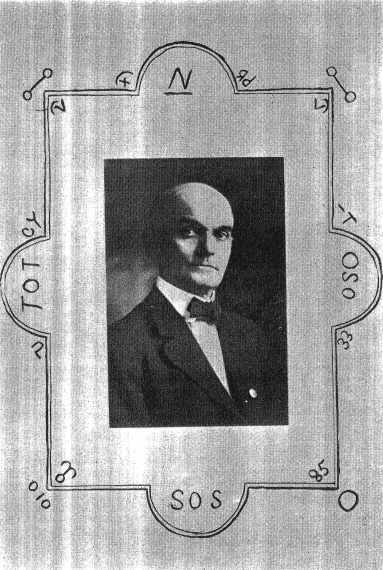
James C. Dahlman, Mayor of Omaha (The Various Insignia Represent Stock Brands with which Mr. Dahlman was connected.)
335
NEBRASKA HISTORY MAGAZINE |
335 |
RECOLLECTIONS OF COWBOY LIFE IN WESTERN NEBRASKA
(By James C. Dahlman of Omaha)
An Address Given at the Annual Meeting of the Nebraska State
Historical Society, Jan. 10, 1922.
Two young Texans, Bennett Irwin and myself, reached our destination, the Newman Cattle Ranch in Western Nebraska, in March, 1878. The ranch, located at the mouth of Antelope Creek on the Niobrara, twelve miles east of where the town of Gordon now stands, was one of the large cow ranches, handling from ten to fifteen thousand cattle. The foreman of the ranch, Billy Irwin, was my partner's brother.
The nearest ranches to the Newman Ranch, were the Hunter Ranch, (20 miles above, on the Niobrara) and the Circle Ranch (forty miles below). This latter ranch now is called the Boiling Springs Ranch, and is owned by Jim Quigley of Valentine, Nebraska, one of the old timers. These two ranches handled about the same number of cattle as the Newman ranch. There were, of course, other ranches all through Western Nebraska, but they were miles apart. The terminus of the Elkhorn Railroad, now the Chicago & Northwestern, at that time was Neligh, Nebraska.
The cattle on the ranches were mostly brought across the country in trail herds from Texas; some few from Oregon, Nevada and Idaho.
These trail herds were made up of two and three thousand head each. It took from five to six months to make the trip.
Trials of the Trail
The crew required in handling a herd consistled (sic) of a foreman, about eight riders, a horse wrangler, cook and mess wagon. Most of the outfits from Texas carried no tents, the men all sleeping in the open. The distance traveled per day would be from five to twenty miles, depending on feed, water and weather. At night they were "bedded down" and the men stood night guard, divided into shifts. In storms and stampedes every man was called and, on such occasions, it was an all-night job, especially in stampedes. That meant an all-night run in a dark, stormy night, over all kinds of country, and many times when daylight came, the herd would be fifteen or twenty miles from camp. The cattle on the bed ground would commence to move at the break of day. The men on last relief would wake the cook and then drift the cattle in the direction they were to travel that day. The horse wrangler would bring
Dahlman, James Charles, mayor: b. Tex. Dec. 15, 1856; s. Charles and Mary D.; ed. pub schs.; m. Hattie Abbott, of Winterport, Me., Dec. 20, 1884. Mem. city, council, Chadron, Neb., 1884-7, mayor 1894-95; sheriff of Dawes Co., Neb., 3 terms, 1888-94; del. Dem. Nat. Conv., 1892; apptd. sec. State Bd. Transportation, Neb. 1897; Chmn. Dem. State Com., 1896-1900; mem. Dem. Nat. Com., 1900-08, and apptd. on exec. com.; 5 times elected mayor of Omaha, present term 1927-30; U. S. marshal for Neb., 1920-21. Home: 2901 Hickory St., Omaha, Neb.
From Who's Who in America, 1926-27, Vol. 14.
|
© 2004 for the NEGenWeb Project by Ted & Carole Miller |
||